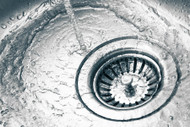How to Disinfect Leather
Posted by Daniel Sutton on Sep 16th 2014
Accidents happen all the time. One bad step, one incidental spill, (or perhaps you woke up one day to find your leather bag had an unfortunate tumble into the dumpster), and all of a sudden that chestnut beauty of yore is a rancid gremlin beyond recognition. It's chill though. Where there's a will, there's a Leather Milk.
How to disinfect leather is the topic for today. A good thing too. Uncleanliness is a pretty resilient pest, and for the first so many thousand years of human civilization, most of the world just kind of had to deal with it. Dung littering the streets, dust caking up boots on long trips, not to mention that horrid smell. But for this great 21st century, we've devised sophisticated weaponry to combat this perennial epidemic: invaluable tools known as soap, alcohol, and bleach. We even have ways to re-nourish parched out hide in the form of conditioner. Our supple skin has never been more spoiled.
But ever so occasionally, the lovely, fluffy curtain is pulled back and we're reminded that those pesky yuckies are still out there. Darn. Well, we'd better do something about that. We'd better do something now.
Trade-Off
Right on that, boss. So your leather's got a bit of a clean problem. Hold the hose, you won't be needing it. Your saving grace is going to be a lot more subtle than dowsing the whole thing. It comes in the form of pH friendly deep cleaner.
First thing you want to know when you disinfect leather: by using powerful leather cleaners, you are going to pull good stuff out with the bad. It's a trade off, but it doesn't have to be an irreversible trade-off. What's going on is that your leather is held together by thousands of tiny fibers, which are themselves knitted together by microscopic protein bonds. These protein bonds prevent the fibers from chafing against each other as your leather bends and flexes by keeping everything lubricated. They oil the machine up. Unfortunately, when there's not enough oil that protein bonds can't do their lubricating thing, the fibers go berserk and start grinding each other to dust. Deep cleaners, often made of alcohol, are indiscriminate rabble-rousers, and will pull your leather's oils out while they purge the bad stuff.
So what can be done to disinfect leather (while not killing it in the process)? It's kind of obvious, really. After the leather's clean, you just gotta put those oils back in. This happens with leather conditioner. Leather Care Liniment no. 1, for example, is a light, effective recipe designed to nourish and restore most leather varieties. You'll need the test it first in a discreet area, of course, to ensure the best results. The same thing with your leather cleaner. Speaking of that, I think I got a bit ahead of myself.
What About the Disinfectant?
As far as honest to goodness formula to disinfect leather, Chamberlains also offer a potent leather cleaner. It's a natural alcohol and water blend called Straight Cleaner no. 2. Alcohol, having even greater penetration abilities than water, is able to pull out contaminants rooted very deep within your leather's matrix - more so than most leather cleaning types. It's the happy balance between imploding the leather and poking it with a stick.
If, however, you have another cleaner you want to disinfect leather with, here's some general tips. I mentioned pH friendly earlier because that part's actually really important. Leather's got a pH value - the measure of acidity or alkalinity - generally around a 4.5, so it's fairly acidic. The problem with many of your commercial and hospital grade cleaners (Lysol, bleach, etc.) is that they've got an alkaline pH level. So what happens is that every time your leather comes into contact with those cleaning agents, a chemical reaction is sparking up while those acidic and alkaline properties try to neutralize each other. I'll spell it out for you: your leather's getting messed up.
So Don't Do That
Keep an eye out for pH values when you disinfect leather. Apart from that, make sure that you always test whatever treatment on your leather before you apply it to the whole thing. Lastly, it helps if it's made for leather specifically. Leather's a pretty unique material when it comes to materials. A good principle to follow is that if you would hesitate to put it on your own skin, it's probably not a good idea to put it on your leather. It was, after all, skin at one time.
That's all I've got for you today leathermancers. Cheerio!
Contributors
Daniel Sutton
Got more leather questions? Suggest a blog topic to us here!

